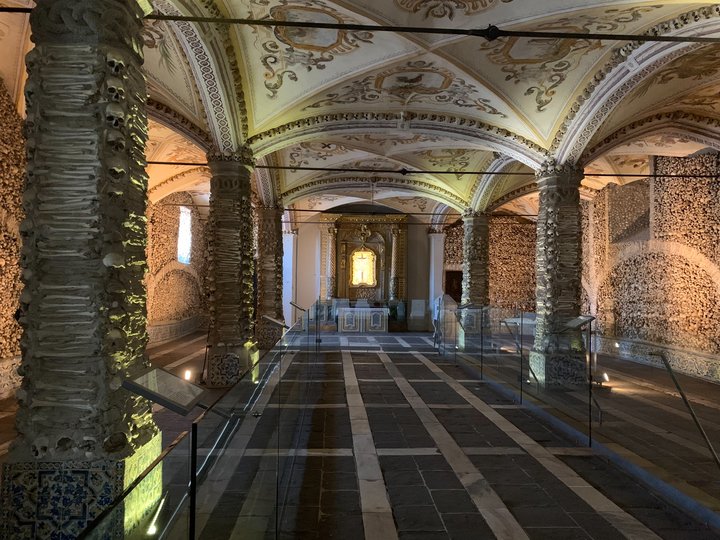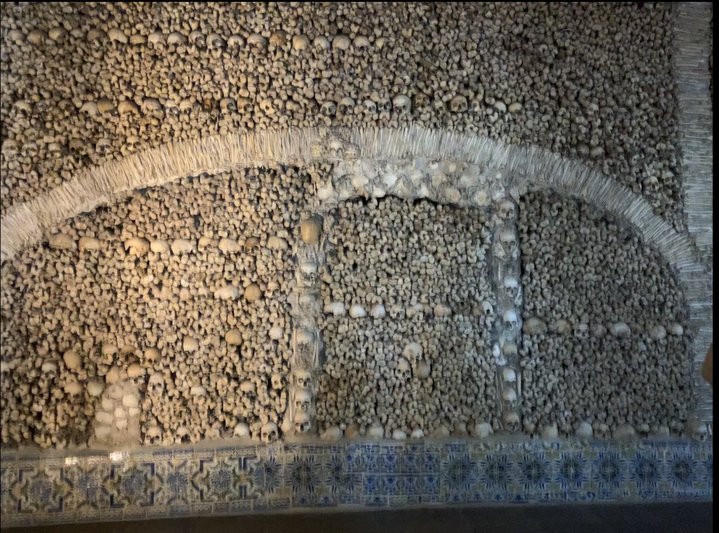Melior est die mortis die nativitatis (Better is the day of death than the day of birth)
– Ecclesiastes, inscribed on the roof of Évora’s Chapel of Bones.
###
What to do with the human body after it’s stopped functioning, i.e. dead? Our ancestors sure had plenty of imaginative options, from Viking internments with full fighting kit to Egyptian granite coffins entombed in huge pyramids to simply dropping cadavers off the side of a ship for a “burial” at sea. Mostly, of course, bodies were simply buried in the ground where they were left to rot until only the bones were left.
This happens surprisingly fast in moist climates — Hamlet’s poor Yorick (“I knew him well”) could only have been “six feet under” for a few years before being disinterred by the gravedigger. In the play, Hamlet holds a nice, clean skull in his hands while he muses on his late pal, “a fellow of infinite jest.”
In arid climates where flesh doesn’t readily disintegrate (mummified Egyptians are recognizable thousands of years after death) societies have taken a more pragmatic approach. In traditional Zoroastrianism, for instance, human cadavers were considered unclean (nasu), an early public health recognition that decaying corpses were a source of disease. The Zoroastrians’ ingenious solution was to place a newly-dead body at the top of a “tower of silence” (dakhma ) where, exposed to the sun, it provided protein to hungry vultures. The birds could do in a few weeks what would have taken hundreds of years in a desert grave.

Purported 1st century ossuary inscribed (in Aramaic) “James, son of Joseph, brother of Jesus.” Originally accepted as authentic, it’s since been declared a modern forgery.
The James ossuary was on display at the Royal Ontario Museum from November 15, 2002 to January 5, 2003. Photo: Paradiso, via Wikimedia.
Ossuaries, or bone-chambers, are another creative approach. Their size varies enormously, from small stone “boxes” containing the bones of a single individual, to entire churches. You can find larger ossuaries in most Roman Catholic countries. This one, the Capela dos Ossos (Chapel of the Bones), is part of San Francisco church in Évora, Portugal.

Évora’s Capela dos Ossos, 60 feet long and 40 feet wide, is lined with the remains of thousands of individuals who died over half a millennium ago. Photo: Barry Evans.

One of six “panels” of bones and skulls. Photo: Barry Evans.
Five hundred years ago, 42 monasteries in the city were each surrounded by the graves of monks and laypeople. At the time, Évora was an up-and-coming center of commerce and culture, and those cemeteries were taking up valuable real estate in that small, dense city whose boundaries were tightly circumscribed by mediæval walls. The Franciscans’ solution was to exhume the skeletons and line a purpose-built chapel with the remains of some 5,000 individuals, where they are now a somewhat ghoulish source of revenue: tourists pay about $6 apiece (half-price for 65+) to view, well, bones. Row upon row of them, floor to ceiling. Over the entrance to the chapel is a salutary inscription: Nos ossos que aqui estamos peos vossos esperamos, We bones that are here await yours.
Carpe diem!
CLICK TO MANAGE